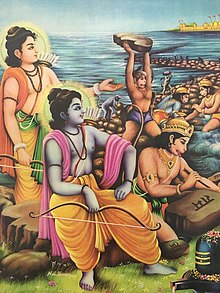Vanara

In
In the epic the Ramayana, the Vanaras help Rama defeat Ravana. They are generally depicted as humanoid apes, or human-like beings.
Etymology

There are three main theories about the etymology of the word "Vanara":
- Aiyanar suggests that vanara means "monkey" derived from the word vana ("forest"), Literally meaning "belonging to the forest"[3] Monier-Williams says it is probably derived from vanar (lit. "wandering in the forest") and means "forest-animal" or monkey.[2]
- Devdutt Pattanaik suggests that it derives from the words vana ("forest"), and nara ("man"), thus meaning "forest man" and suggests that they may not be monkeys, which is the general meaning.[4]
- It may be derived from the words vav and nara, meaning "is it a man?" (meaning "monkey")[5] or "perhaps he is man".[6]
Identification

Although the word Vanara has come to mean "monkey" over the years and the Vanaras are depicted as monkeys in the popular art, their exact identity is not clear.
According to one theory, the Vanaras are semi-divine creatures. This is based on their supernatural abilities, as well as descriptions of
G. Ramdas, based on Ravana's reference to the Vanaras' tail as an ornament, infers that the "tail" was actually an appendage in the dress worn by the men of the
In the Ramayana

Vanaras are created by
Other texts
The Vanaras also appear in other texts, including Mahabharata. The epic Mahabharata describes them as forest-dwelling, and mentions their being encountered by Sahadeva, the youngest Pandava.[citation needed]
Shapeshifting
In the Ramayana, the Vanara Hanuman changes shape several times. For example, while he searches for the kidnapped Sita in Ravana's palaces on Lanka, he contracts himself to the size of a cat, so that he will not be detected by the enemy. Later on, he takes on the size of a mountain, blazing with radiance, to show his true power to Sita.[18]
Notable Vanaras

- Angada, son of Vali, successor of Sugriva, who helped Rama find his wife Sita
- Anjana, Hanuman's mother
- Hanuman, devotee of the god Rama and son of Vayu
- Kesari, Hanuman's father
- Macchanu, son of Hanuman (per the Cambodian and Thai versions)
- Indian versions)
- Vishwakarma
- Nila, son of Agni
- Rumā, wife of Sugriva
- Sharabha, son of Parjanya
- Sugriva, king of Kishkindha, son of Surya
- Sushena, son of Varuna
- Taar, son of Brihaspati
- Tara, wife of Vali
- Vali, Sugriva's brother and son of Indra
References
- ^ ISBN 978-81-8475-182-6.
- ^ a b Monier-Williams, Monier. "Monier-Williams Sanskrit Dictionary 1899 Basic". www.sanskrit-lexicon.uni-koeln.de. Retrieved 23 August 2022.
- ^ ISBN 978-81-206-0140-6.
- ^ ISBN 978-1-59477-558-1.
- ISBN 978-81-88237-02-9.
- ^ Harshananda (Swami.) (2000). Facets of Hinduism. Ramakrishna Math.
- ^ ISBN 90-04-10575-1.
- ^ ISBN 978-81-208-1122-5.
G. Ramadas infers from Ravana's reference to the kapis' tail as an ornament (bhusana) that is a long appendage in the dress worn by men of the Savara tribe.
- ISBN 978-1-59477-914-5.
- ISBN 978-0-520-07589-4.
- ISBN 978-81-260-1809-3.
- ISBN 0-691-06662-0.
- ^ ISBN 978-0-19-804220-4.
- ISBN 978-81-85880-77-8.
- ISBN 978-955-96843-0-5.
- ^ "The Ramayana index".
- ^ "Archived copy". Archived from the original on 20 October 2019. Retrieved 4 January 2009.
{{cite web}}: CS1 maint: archived copy as title (link) - ^ Goldman, Robert P. (Introduction, translation and annotation) (1996). Ramayana of Valmiki: An Epic of Ancient India, Volume V: Sundarakanda. Princeton University Press, New Jersey. 0691066620. pp. 45–47.
External links
 Media related to Vanara at Wikimedia Commons
Media related to Vanara at Wikimedia Commons

